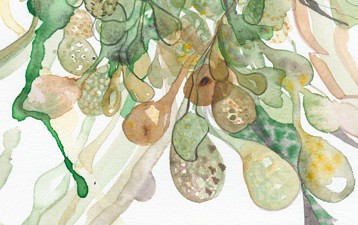Sargassum is a genus of brown (class Phaeophyceae) macroaldga (seaweed) in the order Fucales. Numerous species are distributed throughout the temperate and tropical oceans of the world, where they generally inhabit shallow water and coral reefs. However, the genus may be best known for its planktonic (free-floating) species. While most species within the class Phaeophyceae are predominantly cold water organisms that benefit from nutrients upwelling, genus Sargassum appears to be an exception to this general rule.[1] Any number of the normally benthic species may take on a planktonic, often pelagicexistence after being removed from reefs during rough weather. However, two species (S. natans and S. fluitans) have become holopelagic — reproducing vegetatively and never attaching to the seafloor during their lifecycle. The Atlantic Ocean‘s Sargasso Sea was named after the algae, as it hosts a large amount of Sargassum.[2]
Species of this genus of algae may grow to a length of several metres. They are generally brown or dark green in color and consist of a holdfast, a stipe, and a frond. Oogonia and antheridia occur in conceptacles embedded in receptacles on special branches.[3] Some species have berrylike gas-filled bladders which help keep the fronds afloat to promote photosynthesis. Many have a rough sticky texture, which together with a robust but flexible body, helps it to withstand strong water currents.
The thick masses of Sargassum provide an environment for a distinctive and specialised group of marine animals and plants, many of which are not found elsewhere.
Sargassum is commonly found in the beach drift near Sargassum beds where they are also known as gulfweed, a term also used to include all seaweed species washed up on shore.
Sargassum species are found throughout tropical areas of the world and are often the most obvious macrophyte in near-shore areas where Sargassum beds often occur near coral reefs. The plants grow subtidally and attach to coral, rocks or shells in moderately exposed or sheltered rocky or pebble areas. In some cases (e.g., theSargasso Sea) there are floating populations of Sargassum.
In tropical Sargassum species that are often preferentially consumed by herbivorous fishes and echinoids, there is a relatively low level of phenolics and tannins.[4]
(From Wikipedia, May 31st, 2012)




